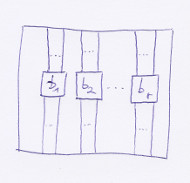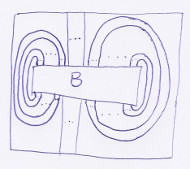Let $\mathcal{P}$ be a finitely generated planar algebra.
Question : Is it also singly generated ?
I ask this question, because, on one hand I've read on this paper of V. Jones and D. Bisch :
"It thus makes sense to ask how many elements of $\mathcal{P}$ are required to generate $\mathcal{P}$ "
But on the other hand, if finitely many elements $(b_i)_{i \in I}$ generate $\mathcal{P}$, with $b_i \in V_{n_i}$ a $n_i$-box, then by using a "direct sum" planar tangle (with $N=\sum_{i \in I} n_i$) $$ T : \bigotimes_{i \in I} V_{n_i} \to V_{N}$$ we produce the $N$-box $B = T(\otimes_i b_i)$ : 
which generate $\mathcal{P}$, because $\forall i$ we can generate $b_i$ (up to rescaling), by applying a "trace" planar tangle on all the $j \ne i$ components of the box $B$: 
I'm not an expert in planar algebra, perhaps this question is obvious, and perhaps this argument is trivially true or trivially false.
